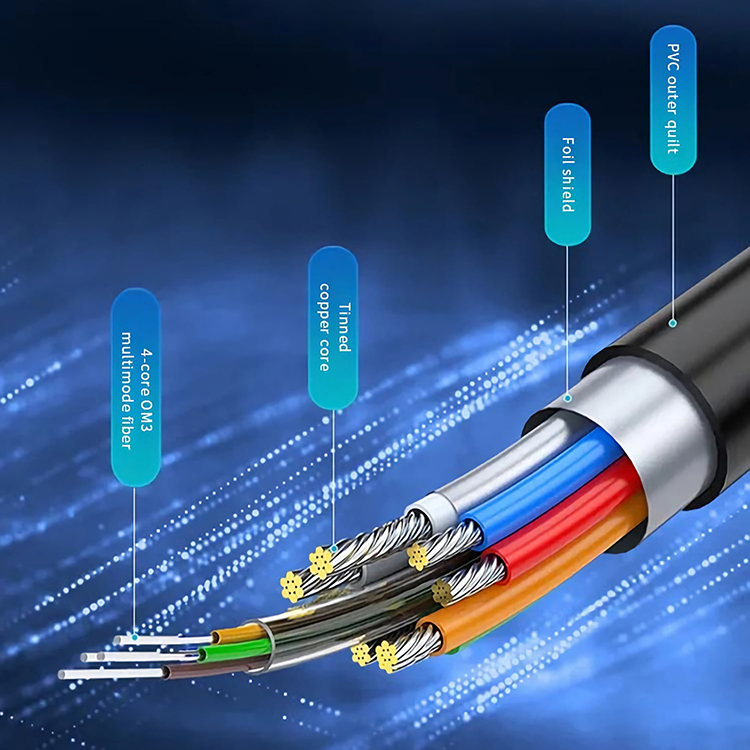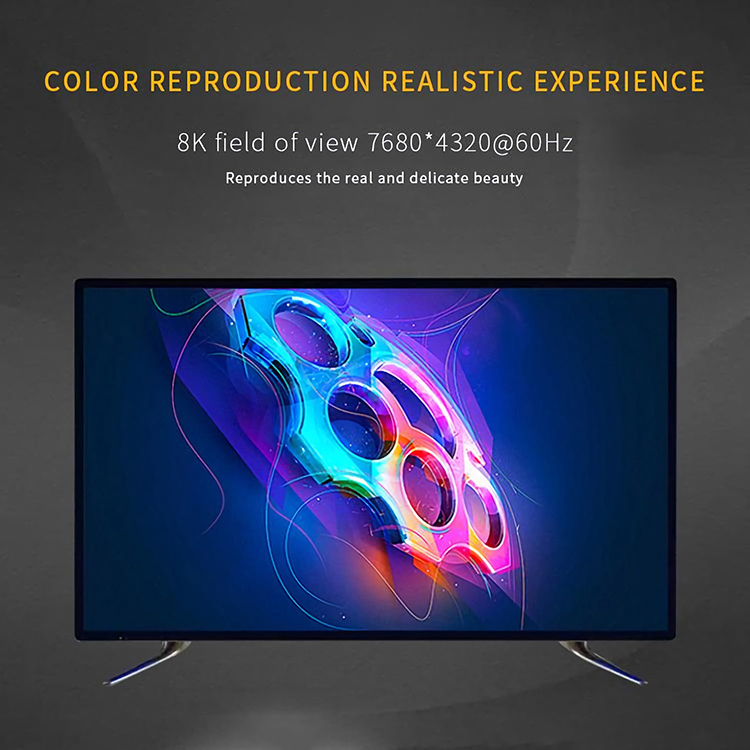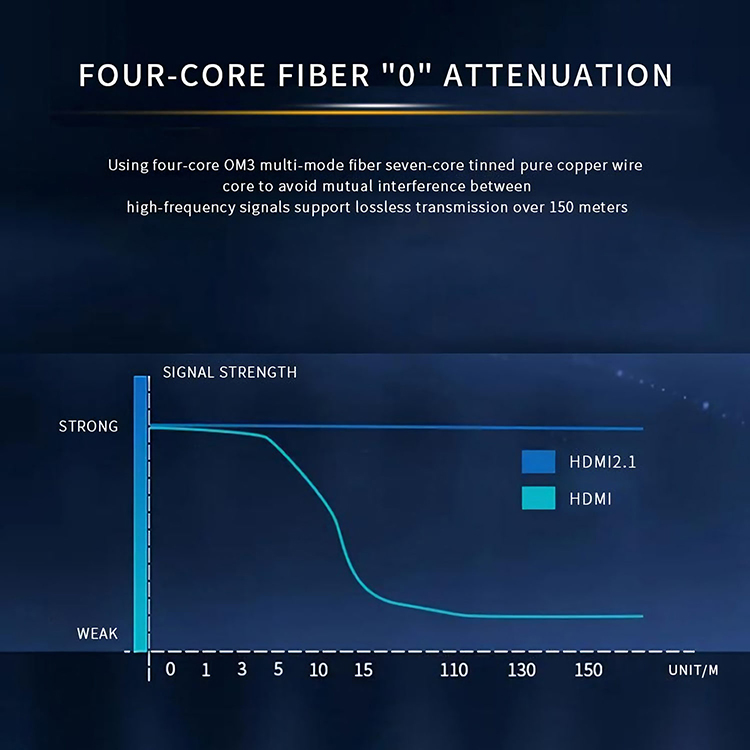What is Active Optic Cable(AOC)?
09/25/2024Are Fiber Optic HDMI Cables Better?
As technology continues to evolve, the demand for superior visual and audio experiences is ever-growing. HDMI cables have long been the backbone of digital connections. With the advent of fiber optic HDMI cables, many are questioning their effectiveness and whether they truly outperform traditional copper HDMI cables. In this article, we will examine the advantages and constraints of fiber optic HDMI cables, focusing particularly on their 8K capabilities, to determine if they are genuinely the better choice.
1. Understanding HDMI and Fiber Optic Technology

1.1 What is HDMI?
The High-Definition Multimedia Interface (HDMI) is the standard for transmitting high-quality video and audio. Since its inception in 2003, HDMI has undergone several updates, with HDMI 2.0 and HDMI 2.1 being the most recent and notable versions.
1.2 The Rise of Fiber Optic HDMI Cables
Traditional HDMI cables use copper to transmit signals, but this material can suffer signal degradation over distances greater than 15 meters. In contrast, HDMI fiber optic cables are a modern solution that uses light to transmit data, ensuring virtually no signal loss over long distances. For discerning customers, the 8K HDMI2 Fiber Active Optical Cable stands out in the market with its ultra-slim design and exceptional performance.
2. Advantages of Fiber Optic HDMI Cables
2.1 Signal Integrity and Ultra-Slim Design
One of the primary advantages of fiber optic 8K HDMI cables is signal integrity. Fiber optics can reliably transmit data over distances exceeding 100 feet without data loss or interference. Nowadays, 8K HDMI cables can achieve 8K@60Hz over distances up to 200 meters (656 ft). The 8K HDMI 2.1 Fiber Active Optical Cable not only features an ultra-thin design but also offers greater installation flexibility. It is suitable for various engineering projects and long-distance wiring scenarios.
2.2 Enhanced Bandwidth for 8K Resolution

For users seeking the ultimate visual experience, such as gamers or home theater enthusiasts, the current 8K HDMI fiber optic cables provide a high bandwidth capacity of 48Gbps, complying with the HDMI 2.1 standard. They support 8K@60Hz, 4K@144Hz, and 4K@120Hz, with backward compatibility. This enables users to enjoy ultra-high-definition visuals and lag-free video experiences.
2.3 Flexibility and Durability
Compared to copper cables, fiber optic cables are more durable and flexible. Active fiber optic HDMI cables can withstand greater stress and are easy to install in various complex construction scenarios. With the enhanced design and manufacturing processes of the 8K HDMI2 Fiber Active Optical Cable, features such as steel armor shielding and TPU abrasion-resistant jackets provide improved interference resistance and durability.
3. Key Features and Benefits of 8K Fiber Optic HDMI Cables
3.1 Experiencing True 8K Resolution
As technology advances rapidly, more content is being produced in 8K, particularly among AAA games and live broadcasts. Using fiber optic 8K HDMI cables ensures access to this unparalleled clarity, providing a clearer and more detailed viewing experience than traditional copper cables.
3.2 Best 8K HDMI Fiber Optic Cable Options
When selecting the best 8K HDMI fiber optic cable, consumers should consider cable length, bandwidth capacity, and device compatibility. In the market, models like our 8K HDMI2 Fiber Active Optical Cable offer enhanced speed, excellent build quality, and extended warranties, making them the most efficient and reliable choice.
4. Are Fiber Optic HDMI Cables the Best Choice?
4.1 Compared to Copper HDMI Cables

While copper HDMI cables have served us well, their limitations, particularly over longer distances, suggest that fiber optic options are more ideal. Using an AOC fiber optic HDMI cable ensures stable quality, free from the common electromagnetic interference associated with copper cables.
4.2 Economic Considerations
Although 8K fiber optic HDMI 2.1 cables often come at a higher price, the investment is justified due to their quality and performance over time. The 8K HDMI2 Fiber Active Optical Cable offers cost-effectiveness, making it a feasible choice.
5. Industry Applications and Consumer Trends
5.1 Applications in Professional Settings
In industries requiring exceptional video transmission quality, such as broadcasting or surveillance, fiber optic HDMI cables are becoming the standard.
5.2 Consumer Adoption and Satisfaction Tracking
Consumers using these advanced cables often report significant improvements in their media consumption experiences, underscoring that fiber optic HDMI cables, including the AOC fiber optic HDMI cable, are essential rather than just an upgrade.
Conclusion
In conclusion, fiber optic HDMI cables offer numerous advantages over standard HDMI cables. Their support for cutting-edge resolutions, long-distance signal integrity, and overall durability make them a standout choice. As the media landscape shifts towards higher resolutions like 8K, the importance of fiber optic 8K HDMI cables in delivering the best video and audio experience is paramount. The 8K HDMI2 Fiber Active Optical Cable, with its outstanding performance and aesthetic appeal, helps cement the place of fiber optic HDMI cables in the market.
